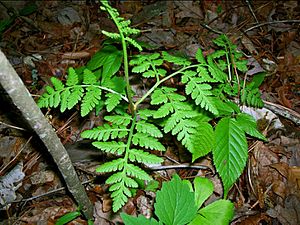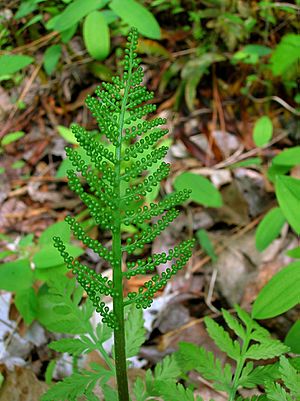Botrypus facts for kids
Quick facts for kids Botrypus |
|
|---|---|
 |
|
| Conservation status | |
| Scientific classification | |
| Genus: |
Botrypus
|
| Species: |
virginianus
|
| Synonyms | |
|
|
The rattlesnake fern, also known as Botrypus virginianum, is a type of fern that lives for many years. It belongs to a plant family called the adders-tongue family. This fern is special because it's the only species in its group, or genus, called Botrypus.
People call it the rattlesnake fern in some parts of North America. This is because it often grows in the same places where rattlesnakes are found. This fern likes to grow in rich, damp forests where there is a lot of shade. It does not do well in direct sunlight.
What Does It Look Like?
The rattlesnake fern is a small plant, usually about one foot (30 cm) tall or even shorter. Its leaf appears in early spring and starts to die off in late summer.
The leaf is shaped like a triangle. It can be from 15 to 50 centimeters (6 to 20 inches) long. The leaf usually lies flat, close to the ground. It is divided into many small parts, making it look very detailed. The leaves are bright green and feel soft when you touch them.
The stem of the fern is round and has two colors. It's often pink or light tan near the bottom. But it turns greenish closer to where the branches or leaves grow.
This fern has two different kinds of leaves. One leaf is sterile, meaning it doesn't make spores. The other leaf is fertile, and it produces spores. The sterile leaf grows about halfway up the stem. The fertile leaf grows at the very top. The fern releases its spores in late spring.
Like other ferns, the rattlesnake fern has a special life cycle called alternation of generations. The plant you see and know as the fern is called the sporophyte.
In some parts of India, this fern has been used as a traditional medicine. It is still used there to help treat stomach problems like dysentery.
Fern DNA and History
Scientists have recently discovered something very interesting about the rattlesnake fern's DNA. Its mitochondria (parts of the cell that make energy) contain DNA from another plant. This DNA likely came from a type of mistletoe.
Scientists believe this mix of DNA might have helped the rattlesnake fern spread all over the world. It is found in many different places today.
For a long time, this fern was grouped with other ferns in the Botrychium genus. But it was always a bit different, especially because of its unique number of chromosomes. Also, it had that unusual mistletoe DNA.
New research shows that the rattlesnake fern is actually a very old relative to most other ferns in its group. It is now placed in its own genus, Botrypus.
Where Does It Grow?
The rattlesnake fern grows in many places around the world. You can find it in many parts of the United States. It also grows in the mountains of Mexico.
Across the ocean, it is found in Australia and parts of Asia, like the Himalaya Mountains. In Europe, it grows in Norway and in the Karelia region of Finland and Russia. It is also found around the Gulf of Bothnia. However, it doesn't grow in other parts of Europe.
In the Himalayas, this fern is quite large and juicy. People there sometimes boil and eat it.
See also
 In Spanish: Helecho serpiente de cascabel para niños
In Spanish: Helecho serpiente de cascabel para niños



